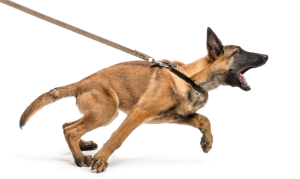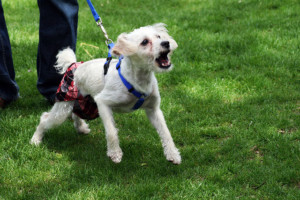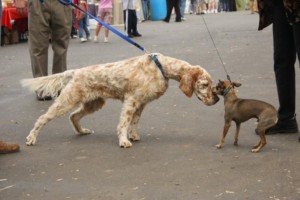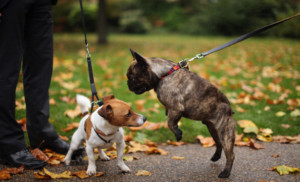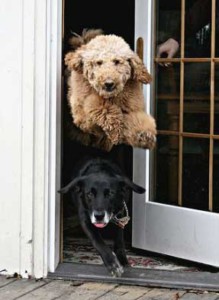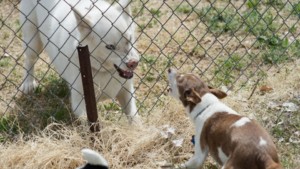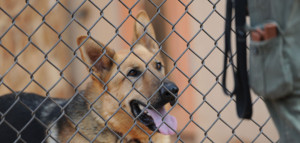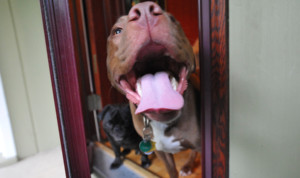How many of you dread walking your dog during the day because the are constantly barking at everything they see? How about those of you who feel embarrassed to let your dog out in your fenced yard because they feel the need to alert the world to every passerby? Raise your hand if you prefer to take your pup out under cover of darkness so they don’t feel tempted to hoot and holler at the world around them?
If any of these scenarios apply to you, you may be dealing with a dog who struggles with reactivity. The good news is that reactivity is often a very misunderstood behavior that is actually quite manageable with the proper training. The bad news… it does take a little bit of work! The huge misconception about reactive dogs is that they are mean or unfriendly or hate strangers or are aggressive towards other dogs. While it definitely depends on the dog in question, these concepts couldn’t be farther from the truth in the majority of reactive dogs!
Reactivity in dogs tends to manifest in behaviors such as barking, whining, lunging, pacing, panting, hyper-vigilance, and other signs of extreme excitability. While none of these behaviors result in aggression, they can quickly tip towards that end of the spectrum if handled inappropriately. More accurately, these are signs of a dog expressing anxiety or frustration. Typically, these behaviors are witnessed in two scenarios: on a leash and behind a barrier such as a fence or a door. Often, the frustration at being unable to access the excitement-inducing stimuli (another person, another dog, etc.) is expressed with these anxiety-ridden behaviors. If handled with aversive training tactics such as leash-popping or verbal or physical scolding, the human can often unintentionally create a more frustrating and anxiety producing situation, causing the dog to redirect their frustration to the closest thing… often their owner.
SO it is important to recognize these signs of reactivity, and learn positive management techniques to ease their dog’s anxiety and produce a positive environment for them rather than a frustrating one. Below, I am going to outline two scenarios: reactivity on leash and reactivity behind a barrier, and discuss how to best begin management techniques to quell those behaviors. Realistically, if your dog has extreme reactivity, it would be prudent to seek out a positive trainer in the area and enroll your dog in a program.
Leash Reactivity:
When dogs meet one another off leash, they naturally greet one another in an arc, reaching around to sniff one another’s behind. However, when greeting another dog on a leash, your dog is restricted in their movement, and forced to greet the other dog head-on, which can be very intimidating and stress-inducing. In order to create “distance-increasing” behaviors, the dogs then may proceed to bark or snarl to warn the other dog that they are not interested in engaging in a fight, but will if they must. Essentially, humans unintentionally create an extremely stressful situation by introducing two dogs in close quarters, with no escape route, and very tight leashes.
So, what do we do to make these awkward greetings a little more comfortable and stress-free? That’s a great question! Here are a few steps you can work on to help Fido feel a little safer in these artificially created meet-and-greets.
- Work on getting your dog to “look” or “focus” on you. Practice this command in a variety of situations before you head out on walks so your dog knows that happy things happen when they focus their attention on you. You can pair the cue “look” with a hand signal of pointing towards your face, and then give them a treat when they oblige. Practice this a LOT in a variety of scenarios, so the cue will be charged when you’re ready to head out on a walk. This way, your dog knows “when I look at hooman, I get treats”. This gives them something positive to focus on, rather than stressing about a frustrating situation they’re about to encounter when there is a dog or other trigger approaching.
- Start asking for Fido’s attention when you see ANYTHING that may be a trigger. Don’t wait for them to become reactive and aroused, as the chance of getting their attention at that point is slim to none.
- Manage Fido’s environment. Keep your dog far away from potential triggers at this point in their training. Whether this means walking them at night, or early in the morning before anyone is out, or only on side-streets, do your best to keep their environment stress-free.
- ALWAYS walk with high-value treats. If you find yourself in a situation where you can’t escape an oncoming trigger, pull your dog to the side, ask them to “sit” and “look” and keep their attention with a steady stream of treats until the trigger has passed. Not only will this focus your dog’s attention on you instead of the trigger, it pairs positive things with potentially scary external stimuli.
As with any training, the key to beating reactivity is continuity and repetition. Keep your commands and your routine the same, and you’ll start to see a change in your dog’s behavior. Additionally, ensure that you are walking your dog with safe gear such as a front-clip harness and a standard 4-6 ft flat leash.
Barrier Reactivity:
This behavior can also be exhibited if your dog is stuck behind a barrier such as a door or a fence and is frustrated that they can’t access the trigger on the other side of the barrier. As with any other type of training, the key is changing your dog’s negative associations to positive ones. For example, your dog associates the front door as something keeping them from greeting the mailman. However, if you change that association to one of a positive nature such as “when I go sit quietly at the front door, I get treats”, you change the dog’s entire perception of the situation. Most owned dogs struggle with two barriers in particularly: the front door and the backyard fence. Here are a few steps I would suggest taking to combat these negative associations:
- Teach your dog a “place” in the home they can go to for relaxation. Start slow by rewarding your dog every time they go sit at their “place”, whether it be a mat, a crate, a room, etc. Then, you can slowly pair the “place” command with the trigger of the front doorbell or knock. Work with a friend to be your “trigger” and get them ring the doorbell. When that happens, ask your dog to go to their place, and reward them when they do so. They must stay at their place while the person enters the house, closes the door, and gets settled. Only when you release your dog from their place, may they greet the visitor. This takes a LOT of practice, but is SO rewarding when it finally clicks!
- Work on an effective “come” with your dog. If they are in the yard, barking at stimuli on the other side of the fence, you want them to listen to you calling them instead of continuing to bark and carry on. Practice “come” in a wide variety of situations with extremely high value treats. You can slowly vary the rate of reward once they get “come” every time with a treat, and eventually even phase treats out altogether. This way, instead of scolding them for their reactivity, you replace that negative behavior with a positive one which they will get rewarded for!
As with any training, the more time and effort you put in, the more effective results you will see. Working with your reactive dog in these ways can improve both the dog’s quality of life, your own stress levels, and your relationship with your dog! If you’re concerned that your dog’s reactivity is tipping into aggression, please consult a positive trainer for a plan!


